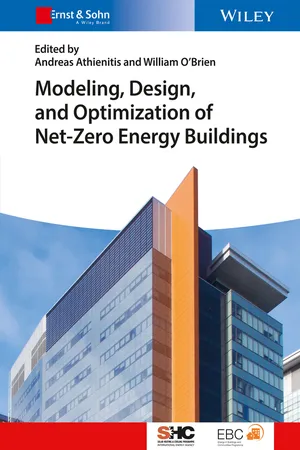
Modeling, Design, and Optimization of Net-Zero Energy Buildings
- English
- ePUB (mobile friendly)
- Available on iOS & Android
Modeling, Design, and Optimization of Net-Zero Energy Buildings
About This Book
Building energy design is currently going through a period of major changes. One key factor of this is the adoption of net-zero energy as a long term goal for new buildings in most developed countries. To achieve this goal a lot of research is needed to accumulate knowledge and to utilize it in practical applications. In this book, accomplished international experts present advanced modeling techniques as well as in-depth case studies in order to aid designers in optimally using simulation tools for net-zero energy building design. The strategies and technologies discussed in this book are, however, also applicable for the design of energy-plus buildings. This book was facilitated by International Energy Agency's Solar Heating and Cooling (SHC) Programs and the Energy in Buildings and Communities (EBC) Programs through the joint SHC Task 40/EBC Annex 52: Towards Net Zero Energy Solar Buildings R&D collaboration. After presenting the fundamental concepts, design strategies, and technologies required to achieve net-zero energy in buildings, the book discusses different design processes and tools to support the design of net-zero energy buildings (NZEBs). A substantial chapter reports on four diverse NZEBs that have been operating for at least two years. These case studies are extremely high quality because they all have high resolution measured data and the authors were intimately involved in all of them from conception to operating. By comparing the projections made using the respective design tools with the actual performance data, successful (and unsuccessful) design techniques and processes, design and simulation tools, and technologies are identified. Written by both academics and practitioners (building designers) and by North Americans as well as Europeans, this book provides a very broad perspective. It includes a detailed description of design processes and a list of appropriate tools for each design phase, plus methods for parametric analysis and mathematical optimization. It is a guideline for building designers that draws from both the profound theoretical background and the vast practical experience of the authors.
Frequently asked questions
Information
1
Introduction
1.1 Evolution to Net-Zero Energy Buildings
| Building systems, design and operation | Current buildings | Smart Net ZEBs |
| Building fabric/envelope | Passive, not designed as an energy system | Optimized for passive design and integration of active solar systems |
| Heating, ventilation and air conditioning (HVAC) | Large oversized systems | Small HVAC systems optimally controlled; integrated with solar systems, combined heat and power; communities: seasonal storage and district energy |
| Solar systems/renewables, generation | No systematic integration – an afterthought | Fully integrated: daylighting, solar thermal, photovoltaics, hybrid solar, geothermal systems, biofuels, linked with smart microgrids |
| Building automation systems | Building automation systems not used effectively | Predictive building control to optimize comfort and energy performance; online demand prediction/peak demand reduction |
| Design and operation | The design and operation of buildings are typically not considered together | Design and operation of buildings fully integrated and optimized together subject to satisfying comfort; integrated design of the above four building subsystems |
1.1.1 Net ZEB Concepts
- The adoption in many developed countries, and by influential professional societies, such as ASHRAE, of net-zero energy [3] as a long-term goal for new buildings;
- The need to reduce the peak electricity demand from buildings through optimal operation, thus reducing the need to build new central power plants that often use fossil fuels; and,
- The decreasing cost of energy-generating technologies, such as photovoltaics, which enables building-integrated energy systems to be more affordable and competitive. This is coupled with increasing costs of energy from traditional energy sources (e.g., fossil fuels).
Table of contents
- Cover
- Related Titles
- Title Page
- Copyright
- About the Editors
- List of Contributors
- Preface
- Foreword
- Acknowledgments
- Chapter 1: Introduction
- Chapter 2: Modeling and Design of Net ZEBs as Integrated Energy Systems
- Chapter 3: Comfort Considerations in Net ZEBs: Theory and Design
- Chapter 4: Net ZEB Design Processes and Tools
- Chapter 5: Building Performance Optimization of Net Zero-Energy Buildings
- Chapter 6: Load Matching, Grid Interaction, and Advanced Control
- Chapter 7: Net ZEB Case Studies
- Chapter 8: Conclusion, Research Needs, and Future Directions
- Glossary
- Index
- EULA